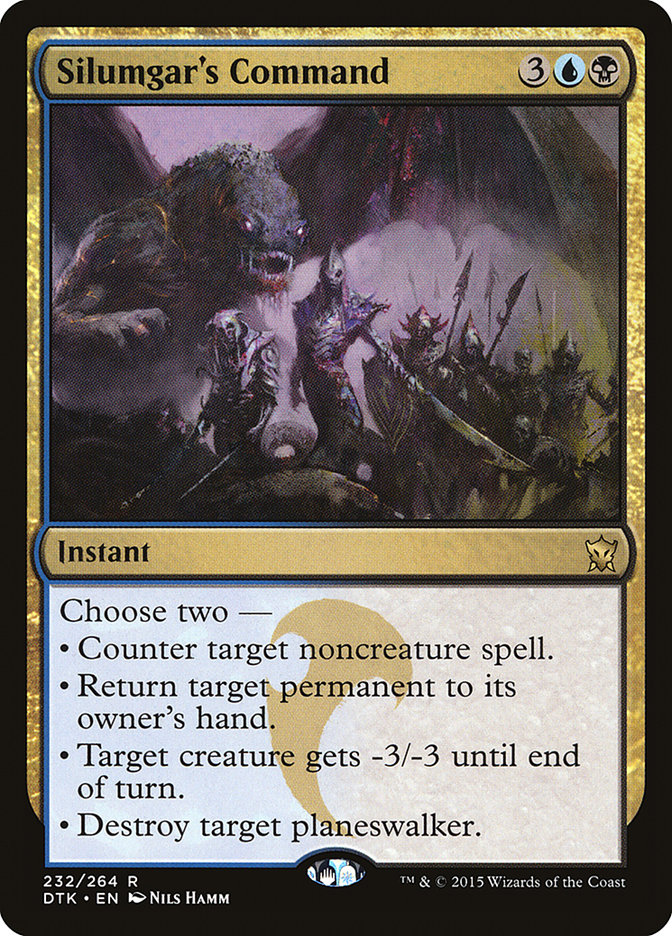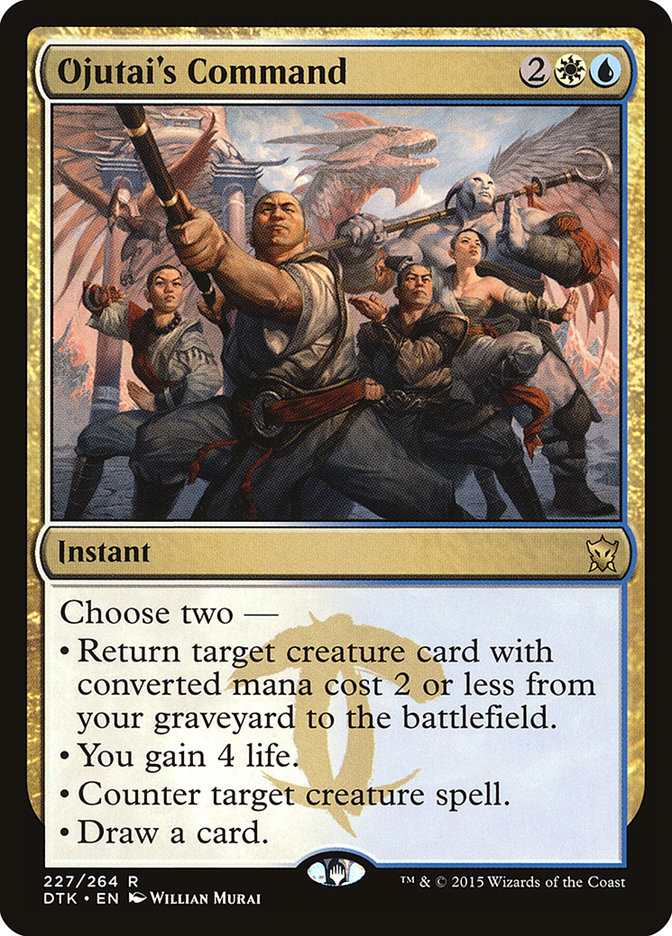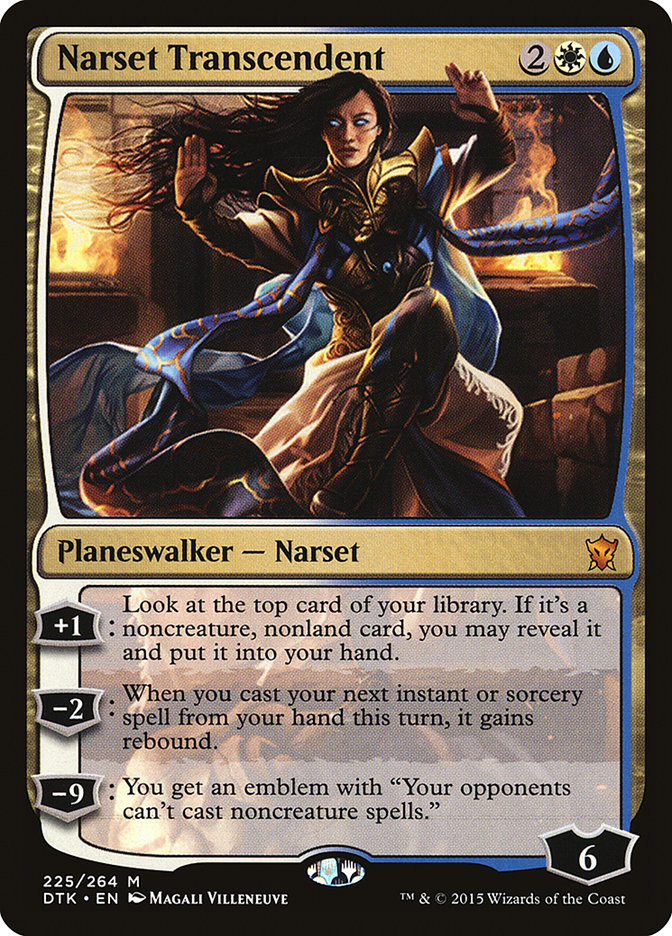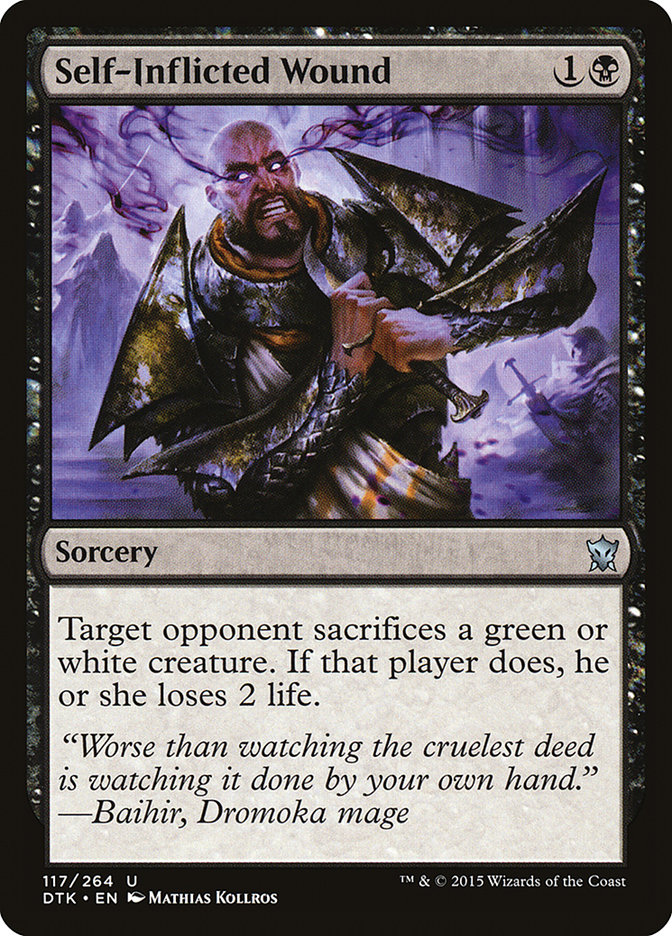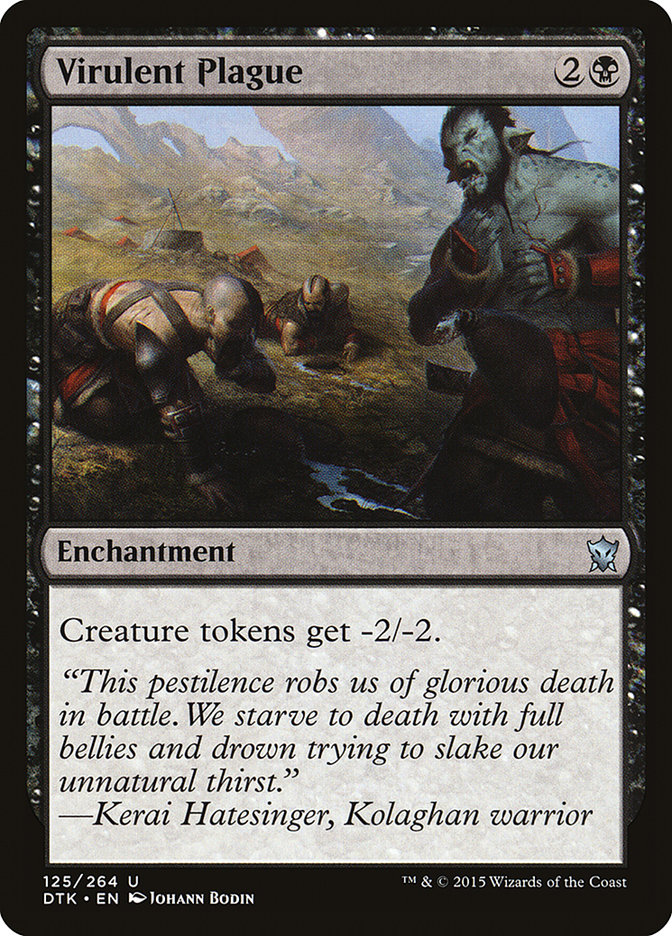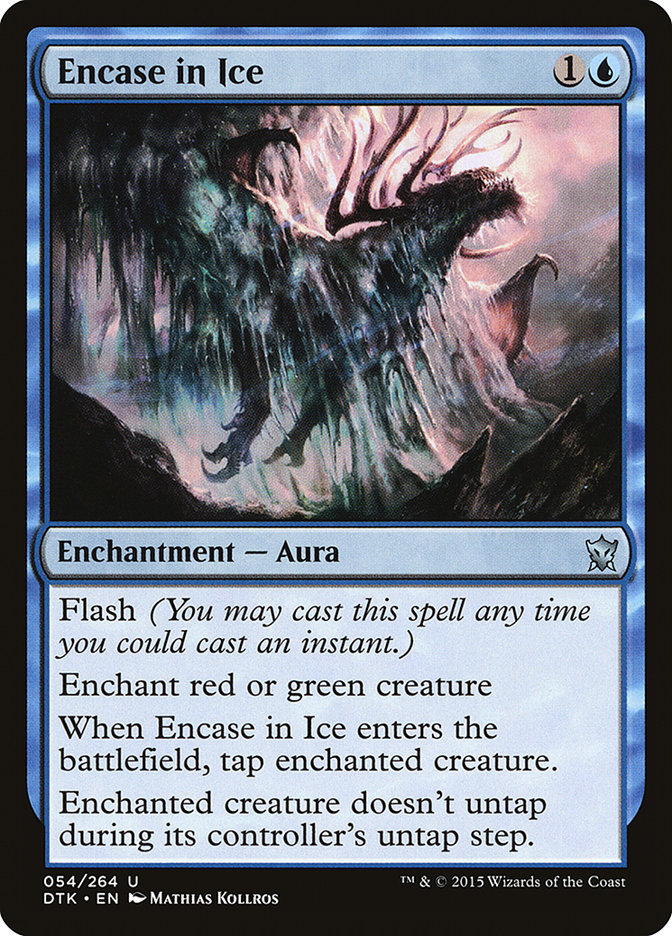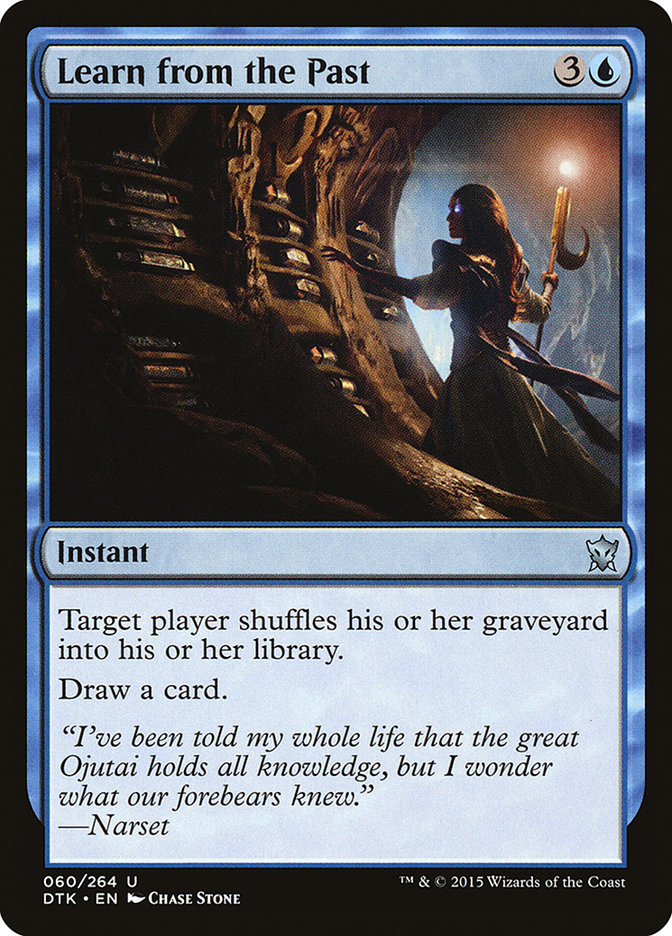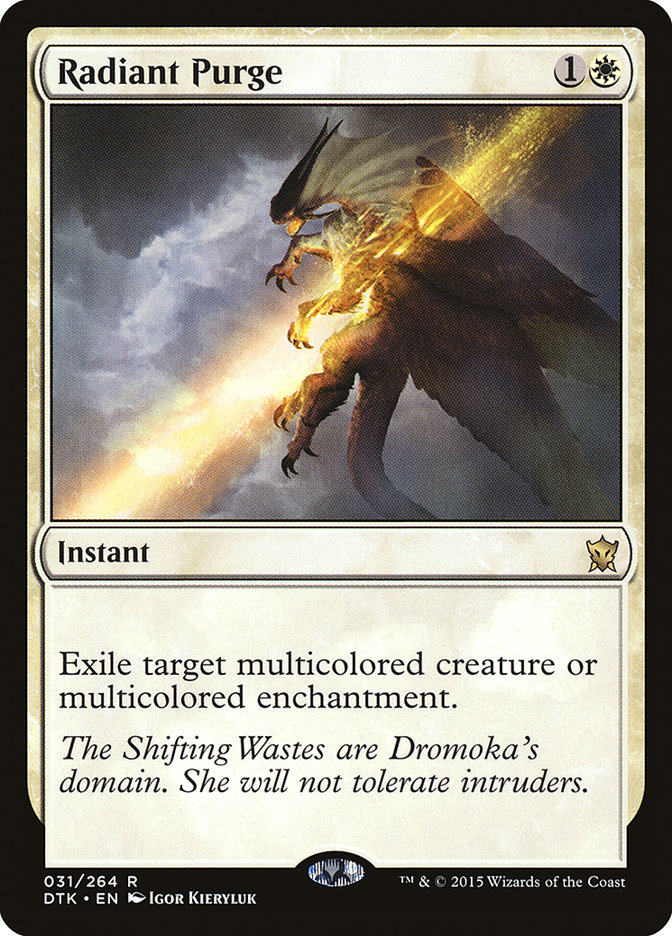Over the past few months I’ve really fallen in love with Sultai. Whether the format was Legacy, Limited, Modern, or Standard, it was Sultai time, all the
time. However with Dragons of Tarkir just a day away, some of the new cards that are not necessarily Sultai are grabbing my attention as I’m brewing decks
for the new Standard environment. The cards I’m interested in are the midrange and control cards, regardless of their clan affiliation. Right now, I am
focusing on the best ways to utilize these new cards in the Esper Control archetype as well as Sultai Reanimator.
I recently read fellow SCG writer and Esper master Shaheen Soorani’s take on Esper, and he presents many excellent ideas in
his article. I will most likely be using his list as a solid starting point for my own Esper list. Esper Control and Sultai Reanimator are the two decks
that I am currently working on for the Standard Open in Richmond. My current plan is to, unfortunately, skip the Season One Invitational due to work
commitments, but I am still traveling to Richmond that weekend to play in the two-day Open. If I do end up deciding to go with a Sultai deck for the event,
I will most likely be focusing on a Sultai Reanimator version of the deck rather than Sultai Control. I think that Sidisi, Undead Vizier is a busted card
that fits perfectly into the Whip of Erebos shell but won’t be fully utilized in a Sultai Control shell.
Regardless of which deck I end up playing, the one card I really want to make sure is in my list is Silumgar’s Command. This past weekend I attended Grand
Prix Cleveland in the wonderful state of Ohio, where I was fortunate enough to make the elimination rounds. During the weekend, the coverage team asked me which command was my favorite
from Dragons of Tarkir. As I’m sure you can now guess, my answer was Silumgar’s Command. My reasoning is that it is an extremely powerful card that has the
exact type of utility you want for a control deck. This one spell gives you the option to Boomerang a permanent, Hero’s Downfall a planeswalker, Last Gasp
a creature, or to Negate a spell. The ability to choose between all of these powerful and unique effects makes Silumgar’s Command a card that I want to
play. Regardless of the archetype you fit the spell into, the card makes deckbuilding easier as the variety of modes can cover multiple holes in your
deck’s gameplan.
The command that was second on my list is Ojutai’s Command. I value this command highly for many of the same reasons as Silumgar’s Command. Ojutai’s
Command provides multiple powerful options while providing utility in a slightly different form. A counter that also draws a card isn’t something that
Abzan decks are excited to run their Siege Rhinos into. The ability to gain four life while returning an early blocker to the battlefield is something that
is powerful against the aggressive strategies. Both of these commands have multiple powerful modes that you can use in specific situations. When evaluating
modal cards like the Charms and the Commands, variety is often something that makes the spell more powerful. I think that both of these commands will
contribute to control strategies being even more viable then they were before Dragons of Tarkir becomes Standard legal.
The other card that is really drawing me to Esper is Narset Transcendent. Often in control strategies, it is ideal to play as few creatures as possible. As
a planeswalker, Narset does a great job of rewarding the control player for this typical deck composition. Narset’s loyalty is very high for a four-drop,
and her ultimate can be very powerful against many different decks since your opponents feel obligated to flood the board with creatures in an attempt to
remove her from the board. Using the decklist from the Esper article
that Shaheen presented, you are likely to hit about 50% of the time with Narset’s +1 ability. If you look deeper, however, you’ll realize that is actually
even more likely to profitably use the ability since Shaheen is running twelve Temples and four copies of Dissolve. The scry ability combines powerfully
with Narset to allow the Esper deck to gain card advantage reliably while smoothing out draws throughout the game. In addition, Narset can also provide
card advantage through her-2 ability. Casting a card like Dig Through Time is normally devastating enough for your opponent, but the ability to play the
spell again on your next turn for free is just ridiculous. Narset’s presence in the deck also makes other spells such as Utter End, Hero’s Downfall,
Thoughtseize, and any of the commands that much more powerful.
I mentioned my potential interest in a Sultai Reanimator deck for this weekend, and there are a few reasons for that. A few weeks ago at Grand Prix Miami I
played a Sultai Reanimator deck, but instead of using Sidisi, Brood Tyrant I focused on a constellation theme with Eidolon of Blossoms and Doomwake Giant.
The printing of Sidisi, Undead Vizier leads me to believe that there is more incentive to playing Sidisi, Brood Tyrant instead of Eidolon of Blossoms. I
think this is one of the biggest decisions that has to be made for the construction of this deck in Dragons of Tarkir Standard. Sidisi, Undead Vizier
contains a powerful effect that also has synergy with the rest of the deck. This leads me to believe that it could potentially be a breakout card in
Standard–maybe even in Modern eventually. I think that Sidisi, Undead Vizier is most likely going to take the position that Doomwake Giant once held in
the deck, which may mean that Silumgar, the Drifting Death can also be played in this new version of the deck to fill the role of handling low toughness
creatures.
Control decks are often shaped as a reaction to the current metagame. Although I have suggested some numbers for different cards, ultimately the final
number for a control decklist will be determined based on what decks we anticipate playing against. That being said, I do believe that a proactive control
deck is probably the best way to go in a new Standard format. A proactive strategy makes a card such as Dragonlord Silumgar something that should be
strongly considered in a control shell. It’s a super powerful effect that not only answers a creature or planeswalker, but it also results in a huge tempo
swing when you gain control of your opponent’s permanents. Combined with Thoughtseize or counters to protect it, this card can easily close out games.
Dragonlord Silumgar is also interesting in that it fits perfectly into the two decks that I’m currently interested in.
The other interesting aspect of Dragons of Tarkir is the sideboard options it provides. Self-Inflicted Wound is a card that immediately caught my
attention. As a two-mana removal spell, it is one of Abzan’s worst nightmares. Since many of Abzan’s threats are multi-colored, it is hard to effectively
use a card like Ultimate Price. Self-Inflicted Wound, on the other hand, is able to take out a card like Fleecemane Lion (even when it is monstrous), Siege
Rhino, Anafenza, the Foremost, and Rakshasa Deathdealer among many others. This card could even be brought in against G/R Devotion, G/R Aggro, or a G/R
Midrange strategy. Being able to take out a Sylvan Caryatid is something that hasn’t been possible since Devour Flesh left Standard, and even though
Caryatid has been on the decline lately, it’s still something to keep in mind. The card can also take out Courser of Kruphix or Polukranos, World Eater
which furthers its usefulness. I can see Self-Inflicting Wound becoming a very potent sideboard card for any deck that has access to black mana. In the
Esper shell, the loss of two life for your opponent isn’t too relevant, but that two life is very important for the Sultai Reanimator deck where every
damage counts.
The next sideboard card I like is Virulent Plague. Jeskai Tokens and R/W Aggro will be two popular strategies, as they were both existing strategies that
gained a few cards from Dragons of Tarkir. For just three mana, all token creatures permanently getting -2/-2 is serious business. I would be more inclined
to have this card in my Esper sideboard rather than Sultai Reanimator since the card doesn’t work well with Hornet Queen or Sidisi, Brood Tyrant. In my
current Esper deck, I’m not even sure if I am going to play any copies of Elspeth, Sun’s Champion, so there shouldn’t be any conflict of interest. Once
Standard becomes more established, we will know for sure how strong the token decks are. My gut instinct says that token-based strategies will become more
popular than before due to Secure the Wastes. Speaking of that card, it crossed my mind that this card is an option in the Esper Control shell as a
finisher that also supports your planeswalker suite. The card functions as both a big fireball style finisher, as well as being an early chump blocker
creator that generates blockers to protect the loyalty of your walkers.
Another sideboard card that seems quite powerful is Encase in Ice. For just two mana, this card is a perfect answer to a wide range of threats like Mantis
Rider and Siege Rhino at instant speed. The card is also interesting because if your opponent sees it in game 2, you can potentially side it out before
game 3 when they might bring in enchantment removal. The Esper Control deck doesn’t have any other enchantments, so any enchantment removal that your
opponent sideboards in are dead cards. Situations where you can make your opponent’s cards useless are great ways to gain additional advantages in a
matchup.
The next card I want to talk about is one of my favorite cards of all time: Duress. Duress is the perfect card against opposing control strategies, but is
also very nice against Burn decks since it doesn’t cost you two life like Thoughtseize would previously. In both Esper and Sultai, I would likely want to
have a maximum of six total discard spells. Right now, I am leaning towards four copies Thoughtsieze in the maindeck and two copies of Duress in the
sideboard. Remember when you’re playing a control deck, having full knowledge of your opponents hand is very helpful for maximizing your plays. Duress fits
nicely in both of the decks I’m working on since it is very cheap and efficient.
A somewhat less powerful sideboard card, but something that should not be overlooked, is Learn From the Past. Against graveyard-based strategies, taking
away their highly stocked graveyard and drawing a card at instant speed is a very useful effect. The card also has other applications since it can be used
to shuffle your own graveyard back in during a long control mirror. Elixir of Immortality was previously very useful in this way just over a year ago. You
don’t gain life as you would with Elixir, but this draws a card. This card is not exactly as potent as Elixir was, but I can see this being a useful
Standard sideboard option.
Another card for the Esper Control shell that might turn out to be powerful is Radiant Purge. This card reminds me of Celestial Purge in that it is a very
efficient answer to stopping a specific strategy. This card can be very good against the Abzan Aggro deck, where almost all of their creatures are
multi-colored. It might even make sense to have a few of each of this card and Self-Inflicted Wound since each card has a variety of uses and situations in
which they are most effective.
Finally, Surge of Righteousness can also be an excellent sideboard card and a literal variation on the earlier mentioned Celestial Purge. For just two
mana, you are able to destroy a black or red creature that is attacking or blocking. Unlike Self-Inflicting Wound where the loss of two life is irrelevant,
the two life you gain here can be game-changing. In general, control decks care more about their own life total than their opponent’s since the gameplan
for control is to stay alive until you are able to take over the game with more powerful lategame effects. Although this card is specific, it functions as
a cheap and powerful spell that can be useful in a few different matchups.
Going into a tournament the first week after a new set, I would want to fill my sideboard with one and two copies of cards rather than having the full four
copies of a card. This gives you the maximum variety for an undefined metagame. By having a ton of specific sideboard options, you allow yourself to have a
lot of options in sideboarding as well as in game play. I’ve discussed a lot of different effective sideboard cards that can be used in the Esper Control
shell as well as the Sultai Reanimator deck, but my recommendation for the first week of Dragons of Tarkir Standard would be to make sure that your
sideboard is full of a variety of different options that are effective in multiple matchups. This strategy is effective at any given point in a format’s
timeframe, but it is most true when trying to attack a truly new and undefined metagame.
These are my initial thoughts on the new format, but nothing is set in stone yet. I will continue to put work into the format in an attempt to finalize my
lists. I will be weighing my options and deciding whether I am staying on the Sultai train that has given me so much, or switching to Esper Control.
So what about you guys? Is anyone else considering Esper or Sultai? Which do you think is better with the new set?


